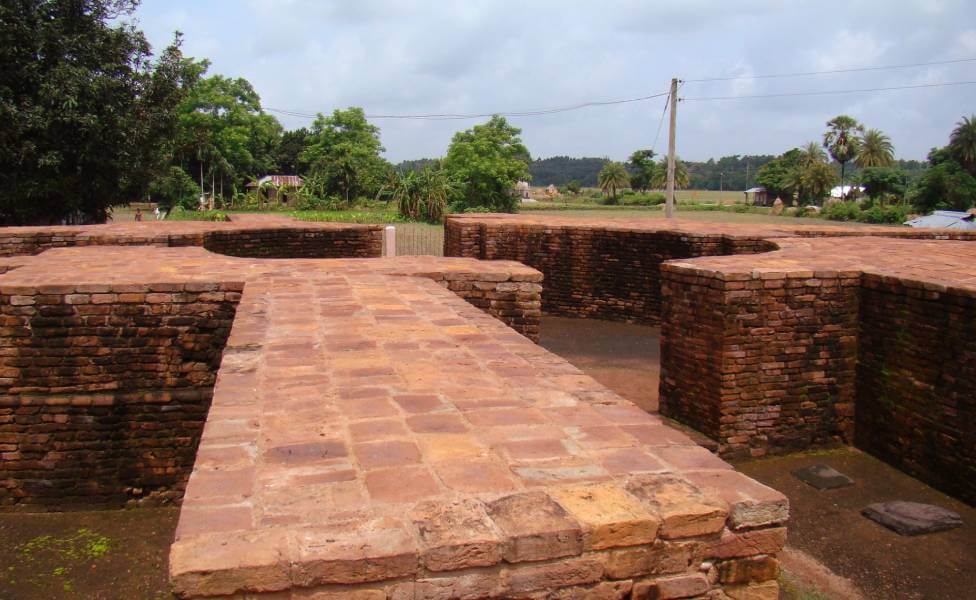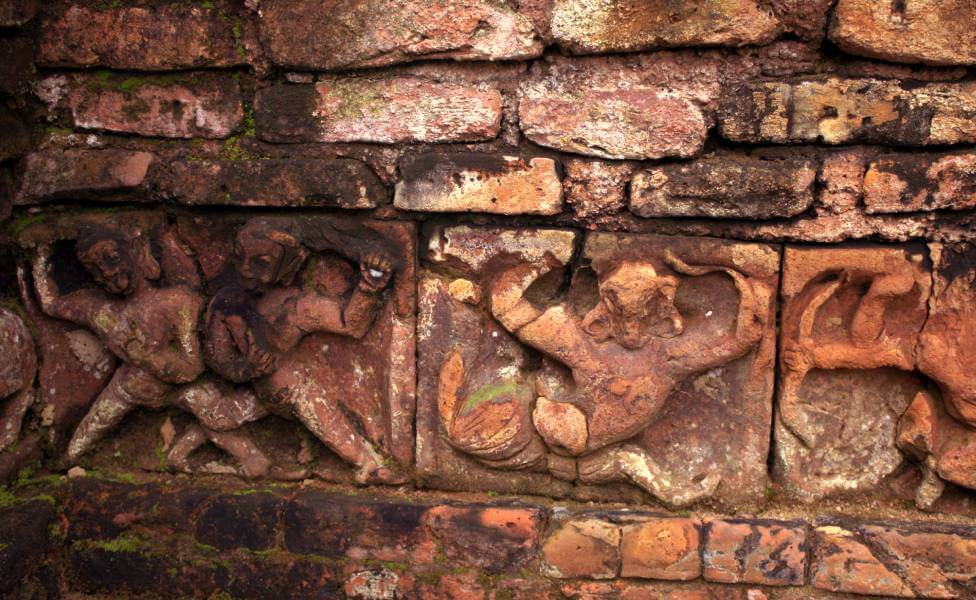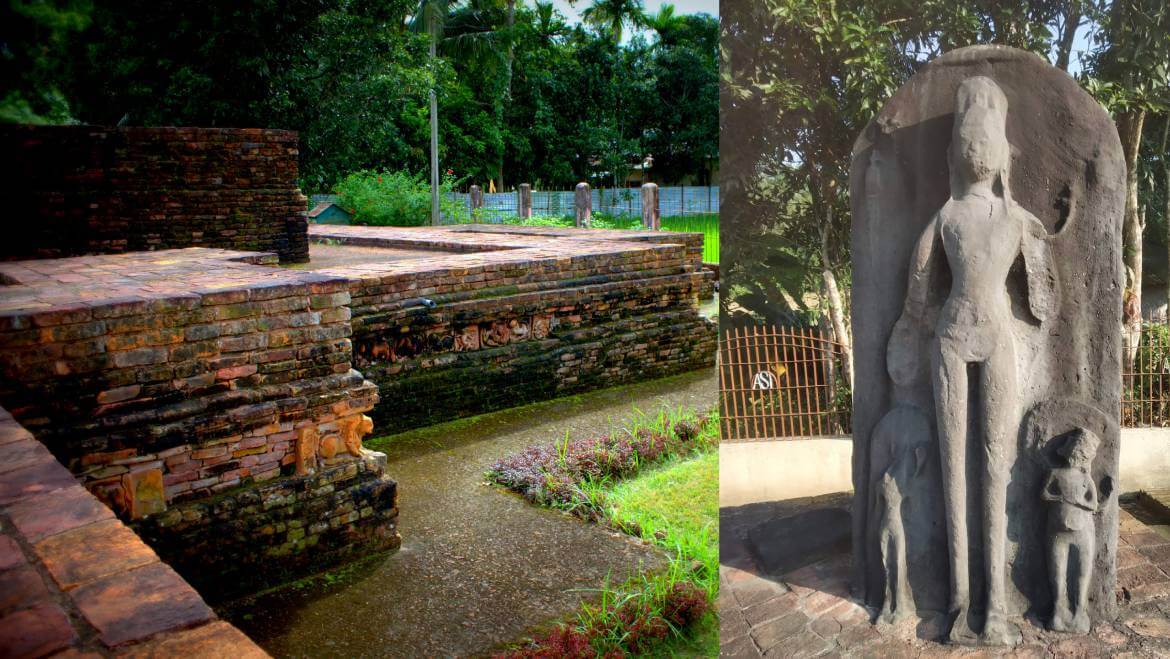The oldest forms of architecture, art, and culture are some of the fascinating things that captivate us today. Besides, who wouldn’t want to see the historical artifacts that archaeologists have unearthed from deep within the earth?
The Buddhist archaeological site of Pilak in Tripura offers an ideal opportunity to witness the works of ancient civilizations. Excavations at Pilak began in 1927 and are still ongoing, continually revealing mysterious and mystical artifacts from the early dynasties of the northeast Indian region. Most notably, the site showcases a remarkable collection of Buddhist art and artifacts, including stupas, monastic remains, terracotta plaques, sculptures, and inscriptions. These highlight Pilak’s history as a prominent center of Buddhism and a pilgrimage destination during ancient times. The ongoing efforts to preserve and conserve Pilak as a national heritage site cater to the interests of history enthusiasts and tourists. Furthermore, the Pilak archaeological sites have unearthed many historical reference sculptures and other artifacts related to Hindu deities and culture. The combination of the artistry of Buddhist and Hindu history makes the place even more fascinating. If you love to explore the secrets buried long ago in history, you will love it here, as it is the best place for historical Buddhist tourism in Tripura.
Top Recommended Tour Packages for Tripura
Enigmatic Past of This Historical Place

Pilak’s history dates back to the 8th and 12th centuries when it played crucial roles in religious and cultural interactions. The medieval period witnessed a significant expansion of Buddhism, not only in India but also in the surrounding regions. Pilak, with its Buddhist monasteries, stupas, and pilgrimage sites, emerged as a center of spiritual and intellectual activities. Situated along important trade routes that connected India with Southeast Asia and beyond, including parts of Bengal and Bihar ruled by the Pala dynasty, Pilak experienced a blending of artistic styles and religious practices from different dynasties. After periods of decline and abandonment, the site was rediscovered during the colonial era, attracting the attention of archaeologists and researchers interested in its historical and archaeological significance. Today, the Indian government and heritage organizations are actively involved in preserving and protecting the archaeological site of Pilak, which has been recognized as an important national heritage site. Recently, the Pilak archaeological site in Tripura has become the top trending destination for Buddhist tourism in the region, attracting people interested in exploring the enormous collection of artefacts found and displayed here.
Archaeological Discoveries
Excavations at the Buddhist archaeological site of Pilak began in 1927, leading to the retrieval of many significant archaeological antiquities related to Buddhism and Hinduism. The vast area of Pilak contains numerous archaeological discoveries showcasing ancient culture, history, and traditions. Some of the significant findings include:
Pilak Stupa Complex
A number of stupas found at the site depict the presence of Buddhist culture in the region. Stupas are hemispherical structures that enshrine the relics of Buddha and other revered figures.
Votive Stupas
These small-sized stupas were built in honour of monks, signifying the importance of Pilak as a pilgrimage site.
Terracotta Plaques
The excavations at Pilak have uncovered a variety of terracotta plaques carved with statues, important events, and depictions of daily life, mostly related to Buddhist mythology.
Buddhist Sculptures
Various Buddhist sculptures, including images of Buddha, Bodhisattvas, and other deities, have been discovered at the site, showcasing the region’s artistic finesse and religious significance.
Guardian Figures
Sculptures of guardian figures like dwarfs, Kinnars, and yakshas have been found at the entrances of stupas and other structures, serving as protectors of different sites and objects.
Monastic Remains
Remains of monastic structures such as viharas (monastic dwellings) and chaityas (prayer halls) indicate the presence of a thriving monastic community during ancient times.
Inscriptions
Several inscriptions in Brahmi and other scripts have been discovered at Pilak, providing valuable historical information about the site and the people who lived there.
Friezes and Carvings
Intricate friezes and carvings on stone and other materials depict Buddhist themes and symbols on various structures at the site.
Other Interesting Blogs to Read
Cultural Significance

The archaeological site of Pilak in Tripura holds significant cultural importance due to its historical, religious, and artistic significance. The site is a prominent centre of Buddhism, with artefacts dating back to the 8th to 12th centuries, including stupas, monastic remains, and Buddhist sculptures. Additionally, the site also features architecture and sculptures related to Hindu gods and deities, highlighting the coexistence of Buddhism and Hinduism in the region during that period. The intricately crafted terracotta plaques and sculptures discovered at Pilak are a testament to the artistic brilliance of the time, depicting Buddhist narratives, mythological scenes, and daily life.
Overall, the site offers a diverse array of artefacts, showcasing cultural influences from various dynasties, including Gupta, Pala, and other contemporary rulers, as well as different religions like Hinduism and Buddhism which makes it undoubtedly the must-visit Buddhist Pilgrimage site in Tripura.
Iconic Structures and Artefacts
The archaeological site of Pilak in Tripura is renowned for its rich collection of Hindu and Buddhist sculptures and artefacts from the 8th to 12th centuries. Some of the most notable discoveries include:
Avalokiteshvara
The impressive sculpture of Avalokiteshvara, the Bodhisattva of Compassion, is one of the largest and most unique in India, symbolising the presence of Buddhism in the region before the dominance of Hinduism.
Narasimha
A stone image of Narasimha, the man-lion incarnation of Lord Vishnu, is among the aged sculptures retrieved and displayed at the archaeological site.
Buddhist Stupa
The 11th-century Buddhist stupa, excavated from Sundari Tila, reflects architectural references from the Pala and Gupta dynasties, as well as influences from the Arakan region of Myanmar and the Mainamati region of Bangladesh.
Surya and Other Deities (Sun God)
Stone images, plaques, and artefacts of various Hindu gods and deities, such as Surya (the Sun God), Ganesha, Durga, and Shiva, highlight the coexistence of Hinduism and Buddhism at Pilak.
Bronze Statue of Buddha
Two bronze statues of Buddhas, discovered in Rishyamukha near Pilak, are well-preserved in the museums at the site.
Mahishasura Mardini
A stone image of Mahishasura Mardini, the Hindu goddess who defeated the deceitful demon Mahishasura, is among the revered artefacts found during the excavation.
Kinnar Figurines
Various images and carvings of Kinnars, mythical creatures that are half-human and half-bird, are present at the site and are believed to be protective beings.
With the significance of Buddhist artefacts and cultural heritages, the archaeological site of Pilak is one of the best Buddhist Pilgrimage Destinations in Northeast.
Timing and Best Time to Visit
The archaeological site of Pilak can be visited between 9:00 AM and 6:00 PM.
The best time for this Tripura tourism for archaeological interests is between October and March, and December hosts the Pilak festival, attracting Buddhist tourists from Nepal, Tibet, Japan, and other Southeast Asian countries.
Other Best Places to Visit Nearby
Tripura offers a wealth of historical places, religious attractions, forests, and wildlife. Some of the destinations near the Buddhist archaeological site of Pilak are:
Tripureswari Kali Temple
Located in Udaipur, about 30 kilometres from Pilak, this temple is one of the 51 Shakti Peethas dedicated to the Hindu goddess Shakti.
Chhabimura
This small village near Pilak is famous for its rock carvings depicting various Hindu and Buddhist deities and scenes from everyday life.
Rishyamukha
A hill near Pilak is considered the birthplace of the sage Rishyasringa, featuring a temple dedicated to him.
Jampui Hills
These hills are located about 50 kilometres from Pilak and are popular destinations for tourists who love trekking and camping. The hills offer stunning views of the surrounding countryside.
Trishna Wildlife Sanctuary
This sanctuary is located about 70 kilometres from Pilak and is home to a variety of wildlife, including elephants, rhinoceroses, and tigers.
Other Interesting Blogs to Read

 +91-9212777225
+91-9212777225 Plan Your trip
Plan Your trip

























